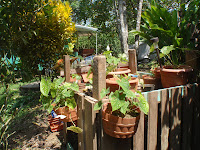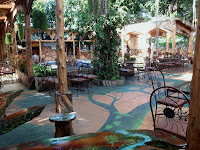


There is an amazing botanical garden on the way into Puerto Viejo that we like to visit called Jardin Botanica La Isla. We went there this past Sunday to buy some new plants for our window boxes. Luckily I brought the camera with me because there was an abundance of tiny red Poison-dart frogs hopping throughout the bromelaids, just waiting to have their photos taken. I was so fascinated by these little guys that I borrowed a book from a neighbor,
A Guide to Amphibians and Reptiles of Costa Rica, Twan Leenders, published by Distribuidores Zona Tropical, S.A. copyright 2001. I have summarized the following details from my research for those of you that find the whole topic of Poison-dart frogs fascinating. For those that who hated biology you may want to stop reading now and just enjoy the photos. Here is what I have found out about these tiny frogs:
There are 133 species of frogs and toads in 8 families found in Costa Rica. The Poison-dart frogs are in the Dentrobatidae family. The Dentrobatidae family includes 8 species in 3 genera: Colostethus (3 species), Dendrobates (3 species) and Phyllobates (3 species). The Poison-dart frogs made famous by Hollywood movies are from this latter genera, a South American species called Phyllobates terribilis. The toxin on the skin of this species is the strongest animal toxin known to biologists and is sufficient to kill 10 adult humans. It is this toxin that is used in blowguns used by indigenous people from the Choco region of Columbia for hunting (for monkeys, sloths and other food - quite sure they don't hunt people although I am sure it could be tempting). The secretion from the frog's skin contains a strong neurotoxin. They cover the darts and arrows with this secretion. When the dart or arrow pierces or even grazes the skin of the target animal the neurotoxin can cause total paralysis, or even cardiac arrest, within minutes. The book,
A Guide to Amphibians and Reptiles of Costa Rica, goes on to state that recent studies have indicated that the source of the chemical compounds (alkaloids) responsible for the toxicity of the skin secretions may be from the TINY ANTS that make up a large percentage of the frog's diet.
The frogs at Jadin Botanica La Isla that are in my photos are also known as Strawberry Poison-dart frogs but they are not the ones used by the Columbian tribes in their blowgun darts. These adorable creatures are from the same Dentrobatidae family but are from the species Dendrobates pumilio. They are found throughout the Caribbean lowlands of Costa Rica. Although they are very small measuring from 3/4 to 1 inch (19 to 24 mm), their bright red-orange coloring and smooth skin makes them hard to miss. They lay their eggs in the concave part of a leaf or shallow depression in the ground, which explains why the ones at the garden were romping throughout the bromelaids. Their diet is largely comprised of tiny ants and they can reach 5 to 6 years of age. Their skin toxin is not deadly to humans but the author of my research book gave an anecdotal account of an encounter he had after touching their skin. After he had handled one of the frogs, he wiped the sweat off his face with his hand and thinks he must have accidentally ingested some of the toxin residue as he he had trouble swallowing and breathing for the next 30 minutes.
I hate tiny red ants. They bite me. It hurts for days. Nothing stops the itch. I am thinking about adding lots of bromelaids to my yard. I believe there are benefits to having a yard full of tiny red Poison-dart frogs instead of tiny red ants.













































